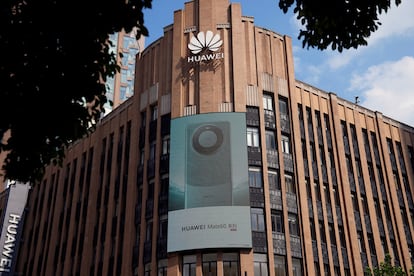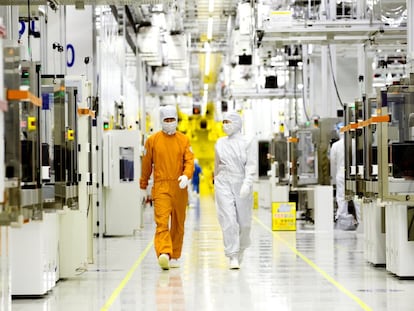China’s next chip battle is for the bottom line
Lasting victory in the chip war will only be within reach if its companies can live without serious government funding

Huawei’s new phone demonstrates China can produce cutting-edge hardware despite U.S. restrictions. But the country’s ability to profitably scale its success remains unclear. Lasting victory in the chip war will only be within reach if its companies can live without serious government funding.
The Shenzhen-based company has not explained exactly how seven-nanometer chips ended up in the new Mate 60 Pro smartphone series. However, a teardown by analysts at TechInsights showed the device’s Kirin 9000s processors were made in China. The researchers hailed a milestone: their observations suggest Semiconductor Manufacturing International Corp produced these without the sophisticated extreme ultraviolet lithography tools of Dutch equipment maker ASML, which Washington has put off limits. Some other components were sourced from non-domestic suppliers, despite U.S. sanctions. All the memory chips appear to come from a legacy range by SK Hynix, even though the company said it has not done business with Huawei since before the rules were introduced.
Gleeful netizens and state media lost no time trumpeting those achievements, while patriotic consumers fueled sales. Huawei is now jacking up shipment targets for the Mate series by 20% to 40 million, local media reported on Tuesday. Analysts estimate deliveries of the Mate 60 Pro could top 5 million this year.
What remains unclear is how accurately SMIC can print designs onto miniscule wafers; any flaw in the famously sensitive technology could decrease the yield of chips. The manufacturer has less experience with this technology than rival TSMC, which has been producing similar products at scale since around 2018. News that the Mate 60 Pro had sold out days after its launch raises the question of whether volumes were capped by the quantity of chips available.
SMIC is already under pressure. The $28 billion company, whose top investors include a state-owned fund, said gross margin halved in the first six months of the year. To keep hitting major milestones, it needs to spend vast sums: research and development costs increased two percentage points from a year earlier to $345 million or 11.4% of revenue, higher than the 8.7% reported by TSMC in its most recent quarter.
State support is generous and may yet grow. SMIC reported $111 million in government grants in the first half, and Beijing is launching a $40 billion fund to generate more cash for the industry. But the pace of progress depends on both how much and how effectively chipmakers invest. Huawei’s flashy phones have hogged the limelight: SMIC’s shrinking margins deserve the same scrutiny.
Huawei started preselling its Mate 60 Pro+ smartphone alongside a new foldable phone in September. The Chinese company started selling its high-end smartphones Mate 60 and Mate 60 Pro at the end of August.
Sign up for our weekly newsletter to get more English-language news coverage from EL PAÍS USA Edition
Tu suscripción se está usando en otro dispositivo
¿Quieres añadir otro usuario a tu suscripción?
Si continúas leyendo en este dispositivo, no se podrá leer en el otro.
FlechaTu suscripción se está usando en otro dispositivo y solo puedes acceder a EL PAÍS desde un dispositivo a la vez.
Si quieres compartir tu cuenta, cambia tu suscripción a la modalidad Premium, así podrás añadir otro usuario. Cada uno accederá con su propia cuenta de email, lo que os permitirá personalizar vuestra experiencia en EL PAÍS.
¿Tienes una suscripción de empresa? Accede aquí para contratar más cuentas.
En el caso de no saber quién está usando tu cuenta, te recomendamos cambiar tu contraseña aquí.
Si decides continuar compartiendo tu cuenta, este mensaje se mostrará en tu dispositivo y en el de la otra persona que está usando tu cuenta de forma indefinida, afectando a tu experiencia de lectura. Puedes consultar aquí los términos y condiciones de la suscripción digital.
More information
Archived In
Últimas noticias
Sydney Sweeney, the actress praised by Trump: ‘Women are up against what society wants them to be’
The Bolsonaro surname: An advantage or liability in Brazil’s 2026 presidential elections?
Raúl Rocha, from jet-setting with Miss Universe to arms trafficking and fuel theft
80,000 barrels of Mexican oil sent to Cuba: Havana drawn into the US–Mexico clash
Most viewed
- Reinhard Genzel, Nobel laureate in physics: ‘One-minute videos will never give you the truth’
- Pablo Escobar’s hippos: A serious environmental problem, 40 years on
- Charles Dubouloz, mountaineering star, retires at 36 with a farewell tour inspired by Walter Bonatti
- Why we lost the habit of sleeping in two segments and how that changed our sense of time
- The fall of a prolific science journal exposes the billion-dollar profits of scientific publishing









































